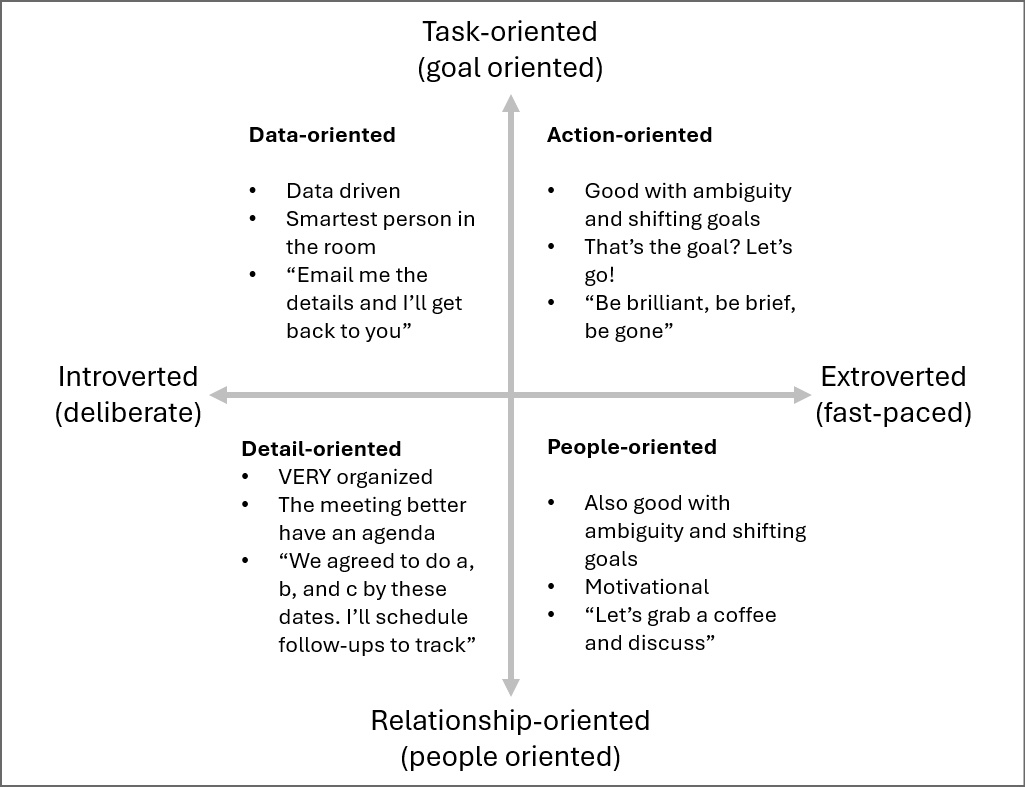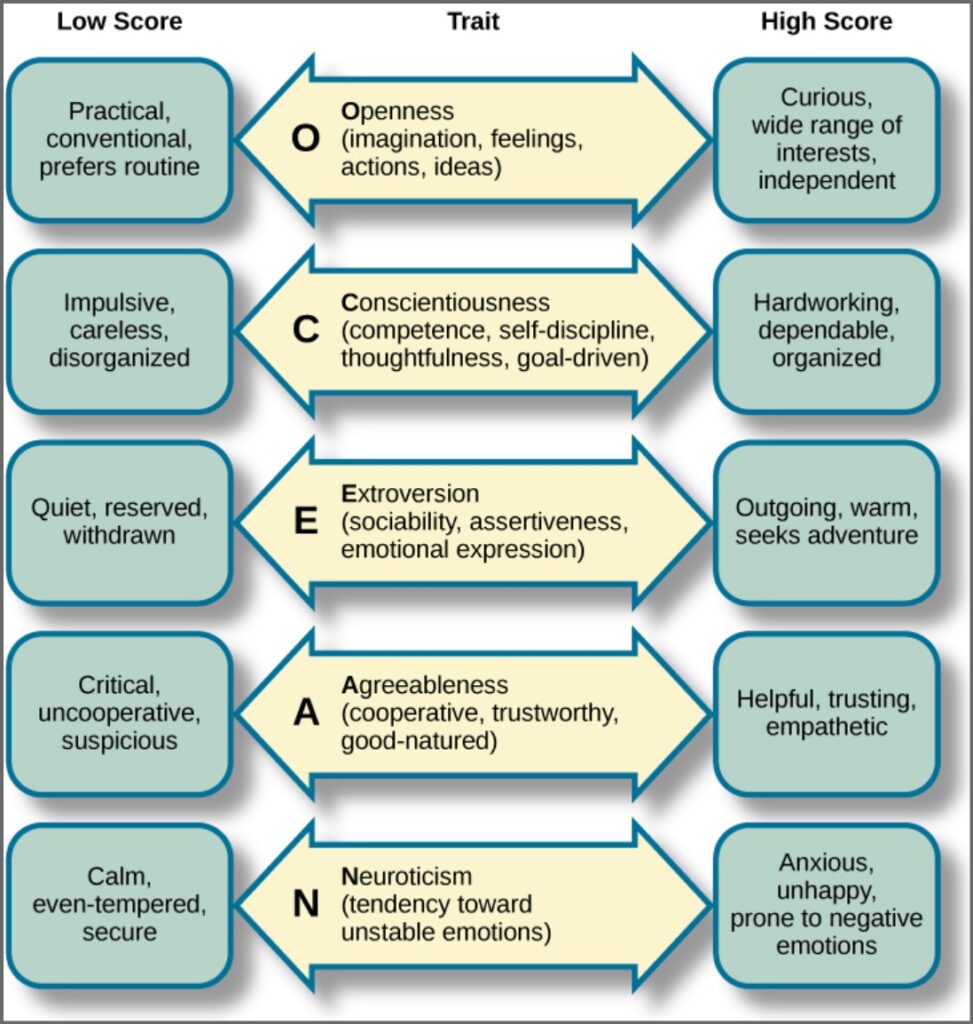
By Andy Ruth, of Sustainable Evolution
Many would argue that time-to-market and the velocity of product and feature release are the most important metric of team performance. But teams without all the personality types represented are unbalanced and struggle with velocity. When building a team, make sure and verify that the team has at least one person that can fill each personality role or plan on filling the gap yourself.
Have you ever met or worked with someone that could inspire? Drive? Organize? Analyze? Or an active listener that makes you feel like you are the only thing of importance while you are speaking with them? Those are personality traits. You have some traits you acquired naturally and through your upbringing, but you can find out what your strengths are and work to develop other skills. Personality tools are, of course, the tools in your toolkit for estimating what personality traits someone has and thereby understanding what skills they likely lend to a team. The goal is to have a balanced team with members who have individual strengths that, when teamed together, have all the skills different personalities have. Some individuals are good at organization, others driving projects to completion, and others that inspire. You can also use the tools to understand yourself and grow in areas you feel you need to grow in. You can also use these tools for workforce development if you manage people, or for building a team for a specific project.
The risk of not using personality trait tools or making sure your team is balanced while forming or growing is that you’ll have all of one personality type and nothing will get done.
Imagine having all dominant personalities that know they are right and use the ready, fire, aim approach. Nobody to organize, inspire, or analyze? Or all analyzers that must be absolutely sure of everything before they do anything, not willing to take a chance. Chaos.
Background
To better understand, let’s jump back to Sigmond Freud (the founder of psychoanalysis) and quickly leap forward to the personality tools we use today. Freud suggested that human personality is centered on the interaction between the id, ego, and superego.
- The id is the primal, subconscious, impulsive part of our personality driven by instinct and desire.
- The superego is moral conscience, influenced by social norms.
- The ego is the rational, conscious part of our personality that tries to balance between the two.
In my experience, you might be able to override your id, but you aren’t going to change some else’s id, you just accept it, and it works or doesn’t for your team, group, project, or company. That’s where you build a team that gels or make the business decision to let someone go. Not personal, just business and for first-time managers, that’s how you handle it, as business and best for both parties, not ever about you and I.
The superego can manifest as company culture, team culture, or other social constructs, and it feels like most personalities are susceptible to and influenced by the social construct they run in. Yes, if I had run with pirates, I might have been darn good at being a pirate.
The ego feels like the space where you have most control over yourself, and in working as a boss, mentor, or coach to help someone else grow. With strong self-awareness, I can see my strengths and weaknesses, and find training, content, or a role model I can observe to see how they wield a skill that I lack so I can learn it. To manage my blind spots, I can find a strong mentor or coach to give brutally honest but fair feedback so I can take action to grow that skill. As a mentor, I don’t judge, I just assess and offer suggestions for closing a gap I sense in the person I mentor.
The psychoanalysis Freud founded suggested the id, ego, and superego had to be balanced to have a healthy personality. However, there was not true empirical support and scientific rigor that defined that analysis. Personality trait theories and tools were developed to fill the gap so we would have frameworks and quantifiable methods to add rigor to evaluation and have methods to put the knowledge to practical use.
So how can you apply that to team forming and velocity? You make sure the team that forms have people that fall into each of the main personality groups. I like to break the tools into two groups – one for long-duration teams like product dev teams and one for short-duration teams, like you might have for consulting gigs or special projects. I use the tools that break personalities into more categories for long-duration teams and tools that abstract personalities into fewer groups for short-duration teams and for my own use to help me interact with others.
Long Duration Teams
One reason long-duration teams build velocity is that they learn their code base in depth, so they know the level of effort and dependencies for delivering new features. However, another reason is because the teams know and trust each other and learn how to work well together. You can accelerate or help grow that team normalization using personality trait tools as a team, with all the team results in one graphic. Typically, a facilitator comes in to talk about the results and provide training on interacting with different personalities after everyone completes their assessment.
Two tools that I use for this purpose are Meyers-Briggs and CliftonStrengths. You’ve likely heard of Meyers-Briggs and might have even taken the test to find out what you are. The Meyers-Briggs Type Indicator (MBTI) test has four sliding scales used to categorize people into one of sixteen different personality types. Accurate, and good if I am building a longer duration team, but I can’t meet a team of twenty, and, over conversation, place each in one of sixteen buckets and remember where they fit as I interact with them. CliftonStrengths, is popular has four primary buckets but places personalities into one of 34 themes so is also better suited for long-duration team building.
Short Duration Teams
For myself, and for consulting, special projects, and other short duration projects, I use personality trait tools that group personalities into four major categories. DISC, True Colors, Four Temperaments, and Hogan Assessments are such tools and feel like they are better suited to this use. The Four Temperaments model links back to Hippocrates and I think it works well for categorizing personalities, but it is based on body fluid descriptions (blood, yellow bile, black bile, and phlegm) so can seem unpleasant. To make it more acceptable, the names used in current models are melancholic, choleric, sanguine, and phlegmatic. Better, but still not great. I’d have a hard time telling anyone they were phlegmatic or that they reminded me of phlegm.
Most tools in this category of tools break personalities into four groups based on an XY grid and describe each group. Here’s an example we’ll call Andy’s Model:

As you can tell from the diagram, it might be easier and more useful to use this type of tool for short-lived teams and for your own personal use. You can also tell that a team would need each of these personality types. Or you fill in where a personality trait is missing. Don’t have someone detail-oriented on the team? You either coach someone in that area or you do it yourself.
- If you’re delivering software, you’ll likely have an abundance of data-oriented people, but it might be tough to find someone detail-oriented enough to lead the daily standups.
- If you have too many action-oriented (we used to call the “A” type personalities) people, each will try to lead and will be relentless trying to win or be first, whatever that means, and morale could suffer.
- If there are too many motivational types, dates might slip to protect the team, and the product might never ship.
Most individual contributors I’ve worked with have loved going through a personality test. When done as a team so we could see who had what types of personalities, we were able to place people in positions where they could provide maximum value, and team velocity increased significantly. They also learned how to interact with each other more effectively so interpersonal friction dropped dramatically across the team.
If you use any of these tools, set the expectations for your team. Before you have team members do the evaluation, tell them the quiz is timed and there are no right or wrong answers. Also tell them this is NOT used for their performance evaluations, it is simply a tool used to figure out what skills the team has and what skills they need to be successful and work well together.
Leadership Growth
When looking for the budding stars in your organization to groom into future leaders, there are other tools to use, such as the Five Factor Model. These tools look at the five primary personality traits or factors that make for successful employees. Large companies often try and find their future leaders among the individual contributors using these tools to identify the stars. Once identified, the potential leaders are invited into special programs with access to leadership and special training to accelerate the growth of their leadership skills.

The five factors, as shown in the graphic from lumenlearning.com show, go by the acronym OCEAN for openness, conscientiousness, extraversion, agreeableness, and neuroticism.
The approach or indicators looked for seem to shift between generations of employees. That said, if you are primarily growing millennials, read the dissertation An examination of the impact of the big five personality traits and work environment on the leadership behaviors of millennial generation employees – ProQuest. If you’ve not ever read a dissertation, I suggest you look at pages 13 and 14 and review the research questions and hypothesis, and if interested, get the paper and read the results.
Whatever you do, don’t overlook the people.
